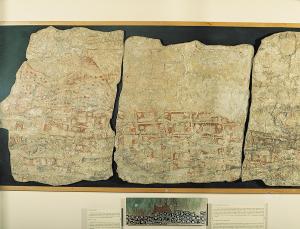At www.newscientists.com/article/dn24492-ancient-mural-may-be-first-picture… (or http://tinyurl.com/njo4uww) … in 1963 archaeologist James Melaart discovered a large mural on a wall of a house at Catalhuyuk (which was pieced together), a town in what is now SE Turkey. He said the mural depicted the town itself with a twin peaked volcano, in the act of erupting. This was nearby Hasan Dag, looming behind the ancient city. It seems that not everyone agreed with Melaart. He was a controversial character that was thought to have doctored evidence on at least one dig. The mural was fragmentary and it was left there as nobody knew if the volcano had actually erupted in the lifetime of Catalhuyuk (which is a very old town). He must have stepped on somebody's toes or something as it seems to be a reasonable deduction. See what you think.

Geologists have climbed Hasan Dag and taken samples from layers of pumice. Extracting zircon crystals they came up with a radiometric date that confirmed the volcano erupted 9000 years ago – at roughly the time of the mural. Game, set, and match. Not so as Stephanie Meece of Cambridge University claims the volcano is in fact a depiction of a leopard skin and the 'town' beneath is mainly a collection of abstract shapes. This was in fact Melaart's original view – but he changed his mind. Why? Wild animals are commonly depicted at Catalhuyuk so it would not be out of place if it was a leopard skin – or something like that. A volcanologist adds, both views may in fact be right as we don't know what a leopard or a leopard skin might symbolise.
